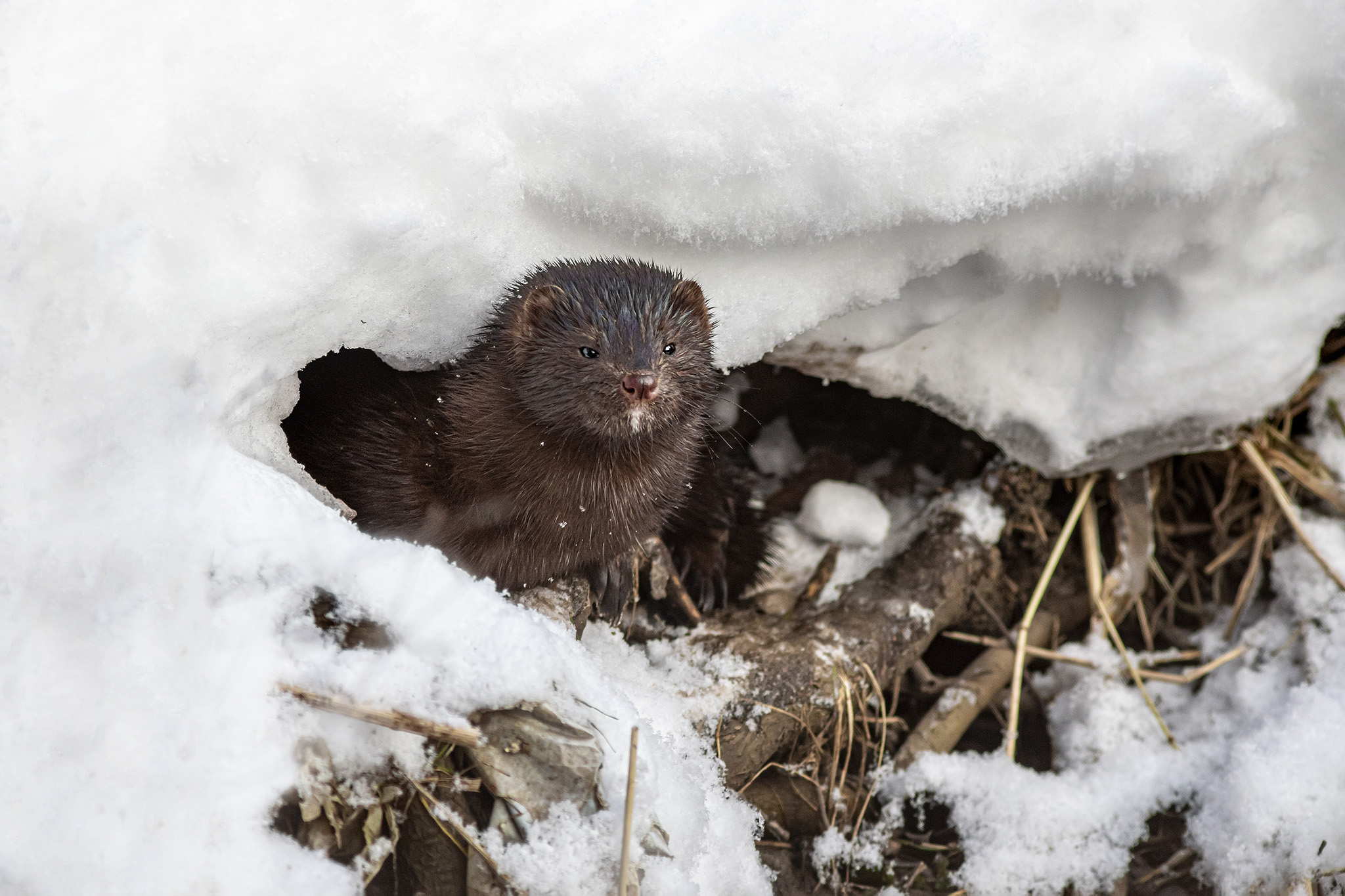The American Mink (Neogale vison) is a semi-aquatic mammal native to North America but has also become widespread in Europe and other regions due to introductions and escapes from fur farms. Here’s a detailed overview:
Description
- Size:
- The American Mink is a medium-sized carnivore, with a body length ranging from 30 to 45 centimeters (12 to 18 inches), and a tail length of 13 to 23 centimeters (5 to 9 inches). Adult males are generally larger than females, with males weighing between 0.7 to 2 kilograms (1.5 to 4.4 pounds) and females typically weighing less.
- Appearance:
- The American Mink has a sleek, elongated body covered in dense, water-resistant fur, which is typically dark brown to black, though lighter shades and white patches on the chin, chest, and belly are common. Its fur is highly valued in the fur trade, which has led to extensive farming of this species.
- It has a pointed snout, small ears, and sharp teeth, all adaptations for its carnivorous diet. The mink’s feet are partially webbed, aiding in swimming.
Habitat and Range
- Range:
- Native to North America, the American Mink is found from Alaska and Canada down through most of the United States, except for the arid southwestern regions. It has been introduced to Europe, Asia, and South America, where it has established wild populations.
- Habitat:
- The American Mink is highly adaptable and is found in a wide range of habitats, typically near water sources such as rivers, lakes, marshes, and coastlines. It prefers dense vegetation along the water’s edge for cover but can also be found in forests, farmlands, and even urban areas.
Behavior and Diet
- Diet:
- American Mink are opportunistic predators and have a varied diet. They primarily feed on small mammals, birds, fish, amphibians, and invertebrates. In some areas, they have a significant impact on local wildlife, particularly bird populations, due to their predatory nature.
- They are excellent hunters both on land and in water, using their agility and sharp senses to catch prey.
- Activity:
- American Mink are generally solitary and territorial animals. They are most active during dawn and dusk (crepuscular), but can also be seen hunting at night or during the day.
- They are proficient swimmers and often hunt in and around water, but they are equally capable on land.
Reproduction
- Breeding Season:
- The breeding season occurs in late winter to early spring. Mating is often aggressive, with males sometimes fighting for access to females.
- Gestation and Birth:
- After a gestation period of about 39 to 76 days, depending on environmental conditions and delayed implantation, the female gives birth to a litter of 1 to 8 kits (typically 4 to 6) in a den, which she prepares in a burrow or hollow log.
- The kits are born blind and helpless but grow quickly, opening their eyes after about 25 days and weaning around 6 to 8 weeks of age.
- Independence:
- The young minks typically leave the mother’s territory by late summer to establish their own territories.
Environmental Impact and Conservation
- Invasive Species:
- In regions where the American Mink has been introduced, such as Europe, it has become an invasive species with significant ecological impacts. It competes with native species like the European Mink and polecats, and its predation has severely affected bird populations, especially ground-nesting species.
- Conservation:
- In its native range, the American Mink is not considered threatened and has a stable population. However, in areas where it has been introduced, efforts are often made to control or eradicate populations to protect native wildlife.
Interaction with Humans
- Fur Industry:
- The American Mink has been extensively farmed for its fur, which is considered highly valuable. This industry led to the introduction of the species in non-native regions and to many escaped or released individuals establishing wild populations.
- Pest Control:
- In some areas, American Mink are managed as pests due to their impact on poultry, fish farms, and native wildlife. Trapping and hunting are common methods of control.
Summary
The American Mink (Neogale vison) is a versatile and skilled predator, known for its luxurious fur and adaptability to various environments. While it thrives in its native North America, its introduction to other regions has led to significant ecological challenges. Understanding its behavior and impact is crucial for managing its populations and mitigating its effects on native ecosystems.
Visited 190 times, 34 visit(s) today
Views: 337
Subscribe to the newsletter:
